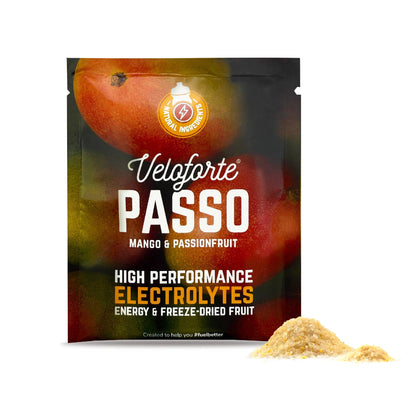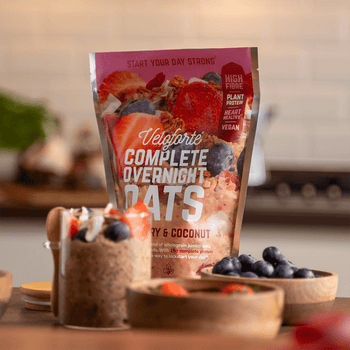Table of contents
When you’re going on a long weekend ride or prepping for a big race, you’ve no doubt planned what you’ll wear, your fuel and the plan of attack (or not) for the lumpier inclines. Hydration, however, can often be an afterthought.
But when you learn that even 1% dehydration can affect your performance, you might want to think a bit more about what, when and how much you’re drinking.
Putting some extra thought into your cycling hydration strategy could be the simple tweak you need to improve your performance, reduce fatigue and boost endurance – and enjoyment – in the saddle.
Here is Veloforte’s expert guide to unlocking the best hydration for cycling.
What happens when you’re dehydrated on a bike ride?
According to the British Nutrition Foundation, just 1% dehydration can have negative effects on the body – and this can also have a detrimental effect on your form and performance on the bike. The more dehydrated you are, the worse the side effects become.
According to British Cycling, just 4% dehydration will decrease your capacity for muscular work. At 5% dehydration you can suffer from heat exhaustion, at 7% you could experience hallucinations, and at 10% you’re in serious territory with circulatory collapse, heat stroke and, in severe cases, death.
While, you’re unlikely to stray into the latter territory, even if you’re mildly-to-moderately dehydrated when you ride, you might notice some of the following symptoms:
- Dry mouth
- Headache
- Poor concentration – which can lead to bad decisions when riding in traffic.
- Increased heart rate – when you’re dehydrated your blood volume decreases so your heart has to work harder. This means your heart rate, metabolic rate and breathing rate can all increase.
- Increased body temperature – your sweat rate decreases when you’re dehydrated, meaning your body temperature can increase – and we all know cycling is much tougher when we’re hot.
- Muscle cramps – although the exact cause of muscle cramps is up for debate, dehydration could be a factor.
- Nausea
- Fatigue – dehydration can increase the amount of glycogen you use, meaning you’ll burn energy faster – and tire sooner – on your ride.

How do you know when you should rehydrate?
"You’re not just drinking for now, you’re drinking for 10-20 miles down the road."
The old rule of thumb, drink to thirst is a good place to start but it doesn’t always work on the bike. In hot temperatures, when you’re working at higher intensities and on long rides, you might need to drink before you think you need to.
Other simple strategies you can use to monitor your hydration
Here are three great tools for spotting when you’re riding low on fluids.
1. Thirst
If you’re dehydrated, you feel thirsty. But be aware you’ll only feel thirsty when you’re already slightly dehydrated. If you’re on the bike, try and drink regularly right from the beginning of your ride so you can catch dehydration before it hits.
2. The Pee Test
Next time you go to the toilet, check the colour of your urine. It should be a pale straw colour. If it’s bright yellow or orange and you need to drink more. Ensuring you’re well hydrated day-to-day makes it much easier to maintain good hydration levels when you’re training.
3. The Sweat-Loss Test
Weighing yourself before and after a session allows you to calculate the amount of fluid you’re losing through sweat. From this weight loss, you can discover how much you should be drinking on your rides to ensure you stay hydrated.
How calculate your sweat loss:
- Weigh yourself in minimal clothing before a 60-minute ride and again when you finish.
- Remember to remove any heavy sodden kit and subtract any fluids you’ve drunk during your workout.
The difference between the two weights is your sweat loss and each 1kg lost is equal to 1 litre of sweat. It might not be possible to replace all of these fluids as you exercise but aim for at least 75%.
How much should you drink before, during and after a bike ride?
Nailing your hydration is one way to get the most out of your time in the saddle. Here’s how to approach every ride.
How much to drink before a bike ride
When it comes to hydration for cycling, there’s no need to drink a large amount before you set off on a ride. It’ll just mean more loo stops. Instead, aim to stay well hydrated the day and morning before. This makes maintaining optimal hydration on the bike much easier.
The NHS recommends drinking around 1.2 litres of fluid daily to replace normal water loss but everyone’s hydration needs are different based on weight, activity levels, the temperature and various genetic factors. If you’re exercising regularly, aim for around 2-3 litres.
It’s a good idea to sip on an electrolyte drink before a long ride, race or tough training session, too. Electrolytes are salts and minerals found in the blood that are lost when you sweat. An imbalance in electrolytes can cause muscle weakness and spasms, fatigue, confusion and dizziness.
We recommend taking on 500ml of electrolyte drink 1-2 hours before prolonged or intense exercise and 150-200ml immediately before you begin.
How much to drink during a bike ride
Aim to drink little and often during your bike ride. Take 2-3 gulps from your bottle every 10-15 minutes – more on hotter days. Start drinking from the very beginning of your ride rather than waiting until you feel thirsty.
For most shorter rides: For rides up to around 60 minutes and lower intensity sessions, drinking water is enough.
For longer rides, races and on hot days: You’ll also need to take on electrolytes to replace what you lose through sweat. Maintaining a good electrolyte balance aids hydration and helps you perform at your best.
Mix a Veloforte electrolyte powder, such as Veloforte Solo, a golden apricot and sage flavoured blend of real fruit, botanicals and pure electrolytes, with water and take 2-3 good sized gulps from your bottle every 10-15 minutes.
How much to drink after a bike ride
After you’ve finished a tough ride you’ll continue to sweat and lose water for a while and it’s important to rehydrate and replace lost energy stores. This will help your body repair and recover from the stress it’s been under.
Ideally, you should aim to take on 150% of the fluid you’ve lost through sweat within one-to-four hours. Although take your time over this as you don’t want to end up feeling bloated and nauseous.
Take on 500ml of electrolyte drink to get your electrolytes back in balance. Veloforte Vivo with its refreshing blend of peach, raspberry and rosehip and strawberry and basil Attivo also contain 22g of carbs, which will go some way to upping your depleted glycogen levels.
If you don’t feel like eating anything straight away, try a Veloforte recovery shake. They contain electrolytes and are packed full of complete protein with a trusted 3:1 carbs:protein ratio to help your body repair, rebuild and recover.

What is the best way to hydrate for cycling?
In summary, here’s our three-point hydration hitlist for the best way to hydrate for cycling:
Ensure you’re well hydrated day to day, drink regularly on the bike – right from the beginning of your ride.
Take on an electrolyte drink on hot days and rides over 60 minutes.
You should also aim to take on 150% of fluid lost through sweat one-to-four hours after your ride as well as electrolytes, carbs, and protein for optimal recovery.
Types of cycling drinks
There are a whole host of drinks aimed at cyclists on the market, all promising performance-enhancing benefits. With so much choice it can be confusing to work out just what you need and when.
To cut through the confusion, we’ve compiled a comprehensive list of different cycling drinks, the benefits and downsides. But here is our at-a-glance guide below:
Best electrolyte powder for cycling
For rides up to 60 minutes: Water will provide all the hydration you need.
For longer rides, tough sessions and hot days: Try Veloforte Electrolyte Powder, a blend of real fruit, botanicals and nature's finest electrolytes. When mixed with water, the hypotonic mix is designed to provide rapid rehydration and keep your electrolytes in balance so you can perform at your best.

Best electrolyte powder for an energy boost
If you prefer to drink rather than eat your carbs on the bike, you could try carbohydrate energy drinks.
Often found in powder form to be mixed at home, the carbohydrates can come from a number of different sources such as sucrose, glucose and fructose
If you’re riding for longer than an hour, you should aim to take on 30-60g carbohydrate every 60 minutes by eating real food or sipping from a carbohydrate drink at regular intervals.
Finding a drink that works for you can be a case of trial and error. Some people find artificial sports drinks can cause GI distress. For a natural alternative, Veloforte’s Electrolyte powders also contain 22g of carbs and the Attivo blend of wild strawberry and basil has natural caffeine for an extra kick.
Shop all-natural Electrolyte Powders here
Best cycling drinks for recovery
Water is the simple way to rehydrate for recovery but taking on an electrolyte drink and/or protein recovery shake can help replenish depleted energy stores, rebalance electrolytes lost through sweat and provide protein to aid muscle repair.
Shop the Veloforte Recovery Nutrition Collection here
Bonus cycling hydration tips
- Drink little and often: aim for 2-3 gulps of water or electrolyte drink every 10-15 minutes.
- Stay hydrated day to day: It’ll give you a much better chance of maintaining hydration on the bike.
- Don’t drink too much: We’ve all heard the horror stories of hyponatraemia – where people (often marathon and ultra runners) drink too much water in endurance events. Drinking too much can be an issue on the bike too, severely diluting the sodium level in the blood and causing bloating, nausea and in severe cases seizures and death.
- Replace lost salts: Among other benefits, electrolyte drinks help prevent hyponatremia, as you’re replacing sodium and lost electrolytes as you go rather than affecting the balance of your body’s fluids.
Practice hydration in training:You don’t want to suffer dehydration or stomach pain on race day so experiment with your hydration strategy and products in training.
Shop Veloforte's Cycling Nutrition Collection here
Why Veloforte?
By harnessing nature’s finest ingredients, we craft real food that really works by delighting your senses and enhancing your daily physical performance, productivity & wellness, naturally.
No compromises, digestive issues, fake flavours, sickly gloop or ingredients you can't spell (or digest). Instead, beautifully balanced natural ingredients, incredible flavours and enjoy total confidence in your foundational health, well-being and performance.
For athletes and adventurers everywhere, our range is fit for purpose and fit for body... created to help you #fuelbetter.





